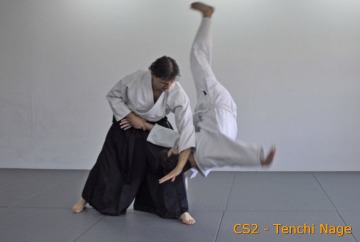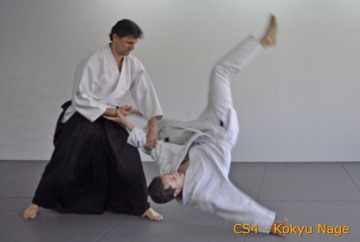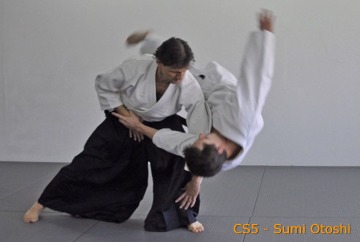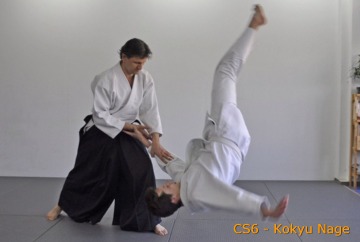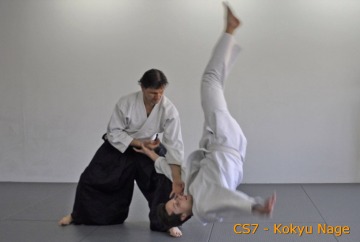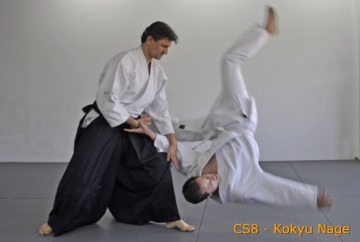


Introduction
A breakfall fall (depreciation of energy) is an element which we encounter in aikido (as in other martial arts) most of the times does not apply in practice. But, it is part of techniques' kinesiology and perhaps one of the most difficult elements in the art of aikido.
And this is why the Aikidoka is called to cope with a difficult situation in which he violently loses his balance or is in danger, sometimes to injure a part of his body. So he avoids this violent situation by performing a fall (ukemi) with the characteristics of the depreciation of energy (breakfall).
Additionally, the Aikidoka making the art of breakfall his own, he acquires a sense of freedom on each technique. This freedom is what ultimately helps him move closer to the ideal realization of the technical implementation,meaning,under conditions of dynamic relaxation. Even in cases the technique is made with excessive speed.
Technical and Quality Characteristics
What are the technical and qualitative characteristics that should a breakfall have so that it would be as close as possible to reality.One would wonder, what is reality? Closer to reality means that the kinesiology of the fall, is the exact result of the cause according to the laws of nature and physics.
Also following the rules of Aikido as the one of harmony, the general philosophy of the art, which is caring for the integrity of the opponent and the spirit of the training, meaning, being fun without the trainees feeling discomfort regardless to the speed of the technique.
In writer's opinion it should have the following characteristics:
1) follow the rules and laws of physics
2) fully utilize the physical characteristics of the human body (weight and body mass, limbs)
3) utilize the dynamic of uke's attack (speed, direction)
4) the fall being the same regardless the speed of the technique
5) it should give us the opportunity to be able to return quickly to normal conditions which the human body must be (straight, upright), and
6) be made with a pleasant and safe way
Note
Obviously we should not overlook that in some cases after a
breakfall the uke is driven to fixation therefore number 5)
under certain circumstances, in the art of Aikido, does not
apply.
Rules
To enable the trainee to understand the kinesiology where
the uke's body must follow, during the execution of
breakfall, one must realize and apply the following rules.
1) Throughout the duration of a technique the two bodies of
the involved should be in contact, with the features we have
already analyzed. The same applies during a nage's attempt
of a throw. So the uke should follow the kinesiology of nage,
leaning on his contact point.
1) καθ' όλη τη διάρκεια μιας τεχνικής τα δύο σώματα των εμπλεκομένων θα πρέπει να βρίσκονται σε επαφή, με τα χαρακτηριστικά που έχουμε ήδη αναλύσει. Το ίδιο ισχύει και κατά τη διάρκεια της ρίψης που επιχειρεί ο nage. Θα πρέπει λοιπόν ο uke να ακολουθήσει την κινησιολογία του nage στηριζόμενος στο σημείο επαφής.
2) As we have mentioned the body functions as a balance. The time an action is exerted by which the uke is led to a fall, his body follows the throwing motion rotating around his center of gravity. There is also a parallel shift of the gravity center downwards, due to the energy of nage's gravity center.
3) During the fall, uke's one leg is lifted in the air anti diametrically with his body that descends while the other leg remains in instant contact with the tatami (Figure B).
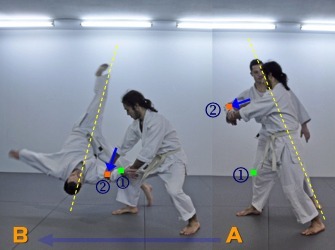 4)
the common course of two bodies is completed at that point
where the body of the uke has developed a dynamic (in terms
of physics kinetic energy).
4)
the common course of two bodies is completed at that point
where the body of the uke has developed a dynamic (in terms
of physics kinetic energy).
The technique that is shown in the next figure (Katate Dori Sumi Otoshi) the uke follows nage's movement up to a point forward and slightly above the nage's front knee (Figure B, point 1). Until that point the two bodies move as one.
We remind that the uke's body wants to return to the equilibrium position, a state in which it would normally be. Also the body due to inactivity (due to its high mass) has a lag in movement. So these two factors create the right conditions to keep up (check point 2) firmly between the two bodies to the point mentioned above.
In uke's substantially there are performed 3 forces a) the power that comes from nage, b) the power that comes from the contact with the tatami (eg friction) and c) the force generated due to rotation (because of angular momentum) . The model of forces is simplified, obviously the forces that are exerted by the weights of body parts should not be excluded but for the ease of understanding the model is simplified.
Therefore, throughout the duration of the movement, uke has momentarily stable equilibrium in relation with nage ,in combination with the motion of throwing. Therefore based on the figure above uke is driven from state A to state B by passing essentially equilibrium points.
From that point uke's body, because of the momentum gained, it revolves around the point (Figure B, Section 2). The free hand slaps powerfully on the tatami (breakfall) while the same time the second leg unsticks of the tatami.
 Noticing
the next figure (technique Katate Dori Tenchi Nage), we
confirm the point 2) of the Rules, that the nage's
kinesiology consists of two distinct movements that are
activated from his center of gravity.
Noticing
the next figure (technique Katate Dori Tenchi Nage), we
confirm the point 2) of the Rules, that the nage's
kinesiology consists of two distinct movements that are
activated from his center of gravity.
The first move has to do with the rotation of uke's body (yellow points) around the center of gravity while the second has to do with the moving of nage's gravity center (orange spots). Basically the entire body moves slightly forward as shown by the movement of the front knee (blue points). Therefore, the combination of a circular and a rectilinear motion give the necessary energy to uke's body to perform his fall safely .
ΤThe nage's hand and uke's head are in contact until the point in front and above the front knee. This should not surprise us since it regards the educational process.
Later, when the techniques will be done with major energy from both roles, the contact will be virtual so the uke's movement will be driven without the contact of arm/head. In this case, the uke has the same feeling as when there was a physical contact.
The education
and the path to freedom!
Obviously for the practitioner to reach at this level there
should be preceded a long period of systematic training on
the ukemis and later on breakfalls. The time depends on the
practitioners perception, the frequency of workouts and
training methodology.
There are many methods of teaching ukemis and breakfall ukemis. Depending on the experience of the instructor, the ability to analyze and simplify together with his communicability, the learning process can be a pleasant experience but also it may end up being a painful process. The latter would obviously be needed to avoid because the practitioner's body creates negative memories of the hasty and unsuccessful cases which makes the learning process difficult.
The whole process takes time, without any violent change of the difficulty degree of the exercises. The practitioner should have the feeling of doing something completely normal every time and this will have as a result body and mind to be able to accept and adopt immediately any new situation.
Based on the following educational process this is achieved to a great extent. So the route is reflected in the following sequence of photographs showing the evolution of ukemis.
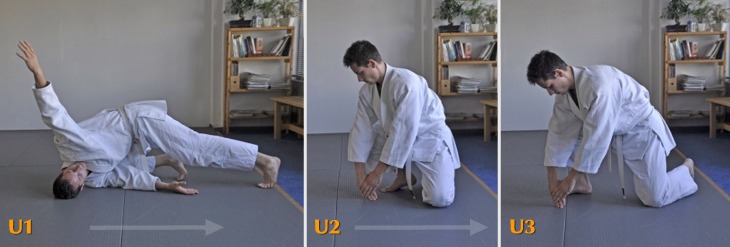
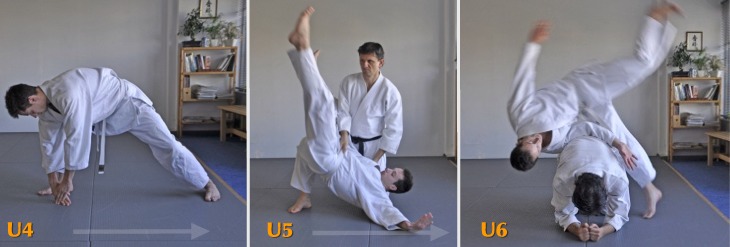
All these stages require each and individual their own time of training and familiarization. Like any other educational process when, for whatever reason,we are in a stage facing a difficulty, the practitioner returns to the previous stage which has already made his property. Meaning to come back to a place of physical and mental balance.
The training is experiential and therefore requires time and no manual, book or DVD, can offer this experience. The practitioner should be put in process of organization and familiarity of his body and mind to the idea of rolling on the tatami and also the idea of approaching his head to the tatami with speed. The second is a difficult task especially for tall students.
Some Cases -
Case Studies
In the following snapshots it is shown different finishing
techniques to the point where the two roles act as one. As
you will see whatever technique been applied, all breakfall
falls end at the same point.

